Greenhouse Herb and Vegetable Production – Part 3/4 – Greenhouse Environment

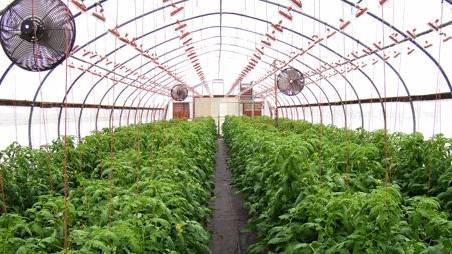
Plants have to be happy to produce high-quality fruits/flowers/leaves and achieve high yields. To reach this goal, plants need to be grown under optimum aerial and root zone conditions. In this third part of our series on growing greenhouse vegetables and herbs, we will focus on the ideal greenhouse environment.
Spacing between rows and plants
It is extremely important because parameters, such as light, air circulation and performing day-to-day tasks, can be compromised. In the greenhouse, every space has to be maximized; therefore, it is imperative to consider plant needs for optimum growth and development while at the same time maximizing resources. For example, tomatoes are grown in rows that are 6 feet apart, each row has two plants (in a V shape) and they are 2 feet apart. In each row, there is a drip system that waters and feeds each plant. Excess water is collected in a trough that runs along the length of each row. Let’s suppose the grower decides to grow lettuce. Changing the greenhouse layout for growing lettuce will be time-consuming, expensive, and some of the volume of the greenhouse will be unused (more cooling capacity will be required since there will be less leaf area index).
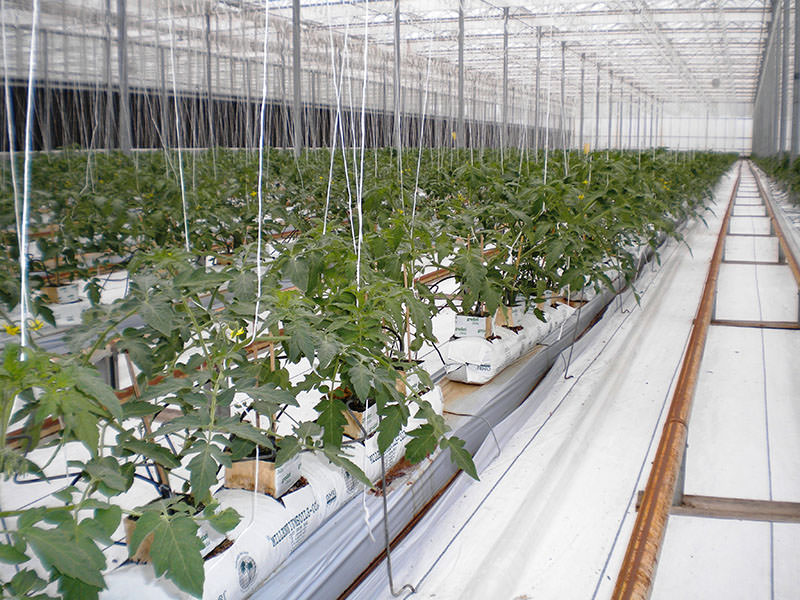
Light
Light is affected by latitude, orientation of the greenhouse, covering material, shadows from the structure and plants, dust and environment. It is a fact that if light interception by plants decreases by a certain percentage, the yield of the crop will decrease at the same percentage. A common problem of low light conditions is flower abortion. Light levels can be improved by using artificial light, especially during the winter. Excessive light intensity can have a negative effect on fruit/flower/leaf quality due to sunburn; this problem can be avoided by installing shade cloth.
Temperature
High or low temperatures have negative effects on plant growth and development. Pest pressure increases as temperature increases. The greenhouse can be considered a solar energy collector. Solar radiation is reflected, absorbed and/or transferred. All physical components making up the greenhouse are affected by these three parameters, but in different proportions depending on the heat transfer coefficient and color of the physical component. For example, steel from the structure is heated by solar energy during the day and it releases the heat at night.
During the summer, shade cloths are used to reduce heat load and air temperature, but it has negative effects since it reduces irradiance (or light levels) for the crop. The shade cloth also subdivides the volume of air inside the greenhouse into two separate microclimates below and above the shade cloth. Moreover, the “buffer” volume of air is reduced resulting in low cooling efficiency. Another way to reduce the temperature is by applying shade compound on the glazing. This method is more efficient because the compound is applied on the outside of the glazing, light is diffused more efficiently through the greenhouse and the volume of air inside the greenhouse is not compromised.
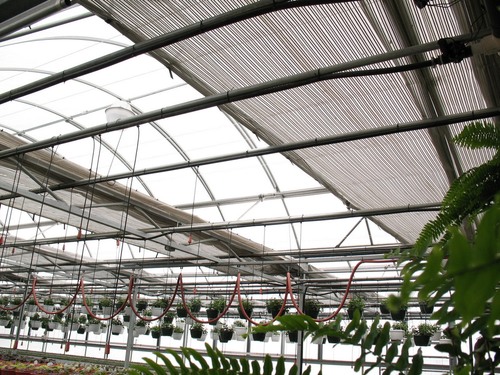
Relative humidity
It is the actual amount of water in the air relative to the maximum amount of water that the air can hold. This environmental parameter has major effects on plant diseases. It is desirable to have daytime relative humidity between 60-80%. For example, botrytis can develop when the relative humidity exceeds 80%, especially in open wounds. At night, relative humidity inside the greenhouse can exceed 95% due to plant respiration (water and CO2 are the product of plant respiration) and lower air temperatures. During winter, daytime relative humidity is high since ventilation does not occur due to low outdoor temperatures. Combined with short days and low light, these are the ideal conditions for fungal diseases, especially powdery mildew.
Vapor Pressure Deficit (VPD)
It is the difference in water vapor pressure at saturation and the actual water vapor pressure, or amount of moisture, at the same temperature. Increasing the VPD will increase plant transpiration, thus plants take up more water and nutrients from the growing medium to supply the demand for water for transpiration. In the greenhouse, it is recommended to have values between 0.3-1.3 kPa for optimum plant growth. By maintaining these values, problems such as Blossom End Rot of tomatoes and peppers (calcium deficiency) can be avoided.
Air circulation
Horizontal Air Flow fans are installed above the canopy, they help to reduce condensation and mix the air along the greenhouse. As a result, there is little fluctuation in air temperature, carbon dioxide and relative humidity along the length of the greenhouse. Each greenhouse bay has to have one set of fans running in one direction and another set of fans parallel to the first but running in the opposite direction. Additionally, it is very important to exchange old air (CO2 is depleted) for fresh outdoor air (high in CO2). It is recommended to exchange the volume of air inside the greenhouse at the rate of 1 exchange per minute. It also helps to lower the relative humidity; therefore, it is possible to have more control over diseases.
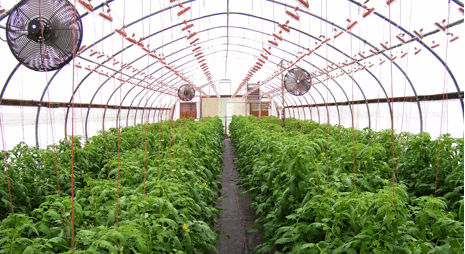
Cooling
It can be achieved by two methods: passive ventilation, where air comes in and out naturally through vents, and active cooling, where air is forced through the greenhouse. Most passive ventilation systems utilize side vents where fresh air enters and hot air leaves the greenhouse through roof openings. The surface area of the vents should be 25% of the greenhouse ground surface area.
Active ventilation requires lots of energy and essentially consists of exhaust fans that force old air out of the greenhouse by pulling in outdoor air through vents located on opposite walls. Active cooling can have additional equipment that can further cool the air. One method is evaporative cooling in which the old air inside the greenhouse is exchanged with fresh air that is forced to pass through a cooling pad. Then, that cool air is distributed through the greenhouse by exhaust fans located at the other end of the greenhouse. The cooling capacity is more efficient if outside relative humidity is low. Air temperature will be cooler close to the cooling pad and warm close to the exhaust fans; the temperature difference will depend on the distance between the cooling pad and the exhaust fans.
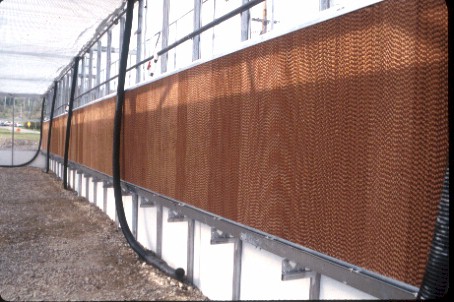
Another method is the high-pressure fogging system; it requires a powerful pump to raise water pressure inside the pipe. The pressurized water will pass through a small nozzle orifice that forms small droplets. The droplets must evaporate (this action takes heat from the environment) before touching the plant leaves to avoid fungal diseases.
Heating
Several types of heating systems can be used. Hot water can be run through pipes throughout the greenhouse. These steel pipes can be run underground and/or above ground between crop rows (they can also be used as rails for cars). Polyethylene tubes can be placed by the plant canopy or under germination trays to deliver bottom heat. Forced air heaters can also be used to heat the greenhouse and can be distributed along the greenhouse by collapsible plastic ducts with holes along its length.
They can be installed above the plant canopy (it may reduce incoming light if used during the day), between rows on the ground or under the drainage troughs. Special care needs to be taken when installing air heaters since natural gas requires oxygen for combustion (plants at night require oxygen for respiration) and the products of the combustion are ethylene and CO. They are toxic elements for plants and they can cause poor growth, especially in new growth, flower abortion and early maturation of fruits. A mixture of air heating and ground heating is more efficient (more control over air temperature and relative humidity especially during winter).
CO2
It is one element for photosynthesis; the inadequate concentration can result in detrimental plant growth. The ambient CO2 concentration is 350 ppm. Its injection in greenhouse plant production is done to achieve 1000 ppm; however, sometimes it cannot be reached because the exhaust fans start before achieving the target concentration.
Part four of this series will address the appropriate growing medium to use for the production of herbs and vegetables.